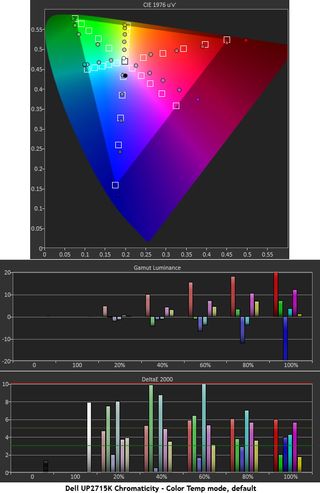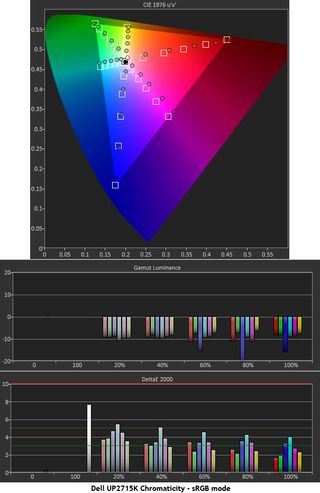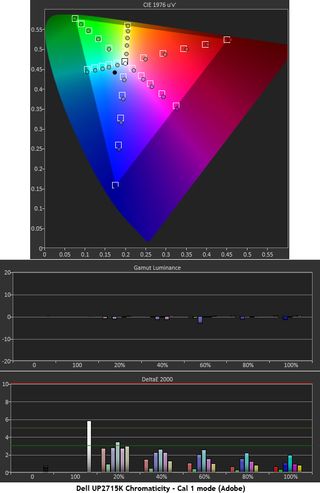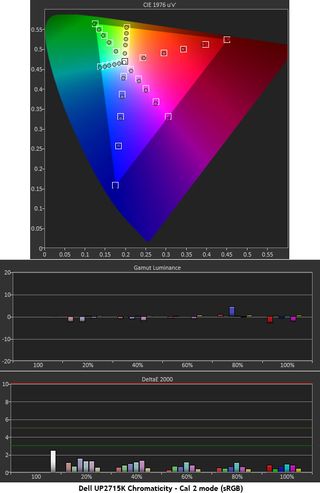Dell UP2715K 27-inch 5K Monitor Review
Users have barely warmed up to 4K (Ultra HD) displays but that hasn't stopped Dell from introducing a 5K monitor: the UP2715K. With professional cred and a factory calibration, we explore what you get for its premium price tag.
Why you can trust Tom's Hardware
Color Gamut And Performance
For details on our color gamut testing and volume calculations, please click here.
We encountered some interesting results in our gamut tests. If you refer back to our review of the HP Z27q, you'll see similar behavior.

The Color Temp mode is based on the UP2715K's native gamut, which is Adobe RGB with some bonus red. It makes for a deeply-saturated though not technically-accurate image. It looks great but it's not appropriate for color-critical applications. There's also a tracking issue with green where lower saturations are off in hue. The average error here is 4.94dE.

The Adobe RGB preset is pretty much the same as above except red is now reigned in. The lower levels are still over-saturated, however. Green and cyan both clip detail at the bright end of the scale because their 80 and 100-percent saturations are almost the same value.

The fixed sRGB preset is the best un-calibrated mode with most of the color points on-target and a balanced luminance chart. This is the most natural-looking image and will match the most commonly-seen source material.

If you want to calibrate the Custom mode, you'll be starting with the native gamut. This means there's work to do with the six-point hue and saturation controls. Fortunately, a lot can be solved with just the grayscale calibration.

After tweaking the RGB gains and making changes to the other CMS sliders, we've improved the error level from 4.89 to 3.81dE. It's not a huge difference but it is a visible one thanks to a more balanced luminance graph. This is the next best thing to performing an auto-calibration.

Using the included software and an i1Pro produces a near-perfect Adobe RGB gamut with amazingly-accurate luminance levels. We used the 118-patch setting, which takes about 30 minutes to complete. If you want to go for that last one percent, you can measure more patches, which takes more time.

The sRGB result is even better than the Adobe one. This is what perfection looks like. The only thing to remember about either Cal 1 or Cal 2 is to specify the luminance level before you start. The Brightness control is locked out in both modes. It can only be set by the software.
Now we return to the comparison group.

Exceptional color performance is possible from the Dell software but the best pro screens can still achieve similar results with an OSD calibration. In fact both NEC monitors can be adjusted with software but their menus allow for precise accuracy anyway. It comes down to the manufacturer's intent with regards to engineering and how much resolution they build into the menu's controls. Dell takes an approach that is easy for the user and includes the necessary software tools in the box. All you need to provide is a meter.
Gamut Volume: Adobe RGB 1998 And sRGB

The precise gamut results extend to the volume measurement as well. The UP2715K achieves almost exactly 100 percent for both sRGB and Adobe RGB. In the Cal 1 and 2 modes the monitor completely qualifies as a professional-grade piece of gear.
Current page: Color Gamut And Performance
Prev Page Grayscale Tracking And Gamma Response Next Page Viewing Angles, Uniformity, Response And LagStay on the Cutting Edge
Join the experts who read Tom's Hardware for the inside track on enthusiast PC tech news — and have for over 25 years. We'll send breaking news and in-depth reviews of CPUs, GPUs, AI, maker hardware and more straight to your inbox.

Christian Eberle is a Contributing Editor for Tom's Hardware US. He's a veteran reviewer of A/V equipment, specializing in monitors. Christian began his obsession with tech when he built his first PC in 1991, a 286 running DOS 3.0 at a blazing 12MHz. In 2006, he undertook training from the Imaging Science Foundation in video calibration and testing and thus started a passion for precise imaging that persists to this day. He is also a professional musician with a degree from the New England Conservatory as a classical bassoonist which he used to good effect as a performer with the West Point Army Band from 1987 to 2013. He enjoys watching movies and listening to high-end audio in his custom-built home theater and can be seen riding trails near his home on a race-ready ICE VTX recumbent trike. Christian enjoys the endless summer in Florida where he lives with his wife and Chihuahua and plays with orchestras around the state.

Qualcomm teases Snapdragon X with no mention of Elite — news of second chip could be coming on April 24

Corsair's Elite 6500 ATX and Elite 2500 Micro-ATX get accent panel options — removable panels available in wood and aluminum

Alleged Zen 5 'Strix Halo' Mobile APU has more GPU cores than RX 7600 XT or PS5 — features monster RDNA 3.5 GPU with 40 compute units
-
Logen_ On the specifications chart, it says that the panel is AMVA, but a little below the chart, it's mentioned that it's an IPS panel instead. Going by the conclusion and contrast ratio, definitely IPS. Also, 3 year warranty, that's.... so little for something that clearly deserves a 5 year or more, in my opinion.Reply -
ceberle ReplyOn the specifications chart, it says that the panel is AMVA, but a little below the chart, it's mentioned that it's an IPS panel instead. Going by the conclusion and contrast ratio, definitely IPS. Also, 3 year warranty, that's.... so little for something that clearly deserves a 5 year or more, in my opinion.
It is indeed AH-IPS not AMVA. Thanks for pointing out our error.
-Christian- -
Jeff_53 Why isn't the MSRP on the first or last page? My interest in the product and features is directly tied to it's price.Reply -
apertotes That contrast... ugh! For 99% of users, contrast is much more important than color fidelity.Reply -
theusual ReplyHow about a test of the DELL S2716DG? Especiall vs the ASUS ROG PG279Q.
Never mind. That would be TN vs IPS. You could compare it to the PG278Q though. -
PellehDin If they fix the price issue - and the current price is about $1,500 and up - you might just skip the article, which they don't want.Reply -
CBender I don't read the review articles just because of that. I am going to read a full review for a product not that I can't afford, but a product that I consider it be way overpriced (not for this particular review)Reply